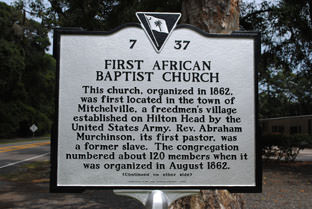Mapping Mitchelville


“…the greater part of the colored population of the island are located a short distance from Hilton Head at a place called Mitchelville…It is an incorporated town, regularly laid out in streets and squares.…There are three churches — two Baptist, one Methodist — and two schools which are taught by AMA teachers."
M.A. Burnett AMA, January 7, 1868
This section of an 1865 map shows the layout of streets and houses in Mitchelville and adjacent Fort Howell on Hilton Head Island. The map confirms historical accounts that described the town as rows of regularly spaced houses built on small lots along broad streets. Orderly and evenly distributed houses are shown in northeast portion of town. It is likely the first houses were built close to the bridge over the marsh at the north end of the island since most of Mitchelville's residents worked at the military encampment.
The 1865 map also shows the arrangement of houses is less regular on the southern, eastern, and western edges of the town. Researchers believe these were some of the last houses built in Mitchelville as the town reached its peak population in 1865. In 2013, archaeologists found evidence of several houses on the southwest edge of Mitchelville. They believe these were some of the last houses built in the town. In addition, researchers found wells and a large garbage dump. These may have been community facilities used by several households.
Mitchelville's Population
There are approximately 464 buildings on the map. In December 1864, a missionary teacher reported there were 456 completed houses, 22 houses under construction, and 2,730 residents. In 1865 a newspaper reported there were 3,000 residents. If four to six people lived in each house, it is likely all of the houses shown on the map existed in 1865.
Community Buildings
The map does not show the difference between residences and community buildings, such as schools and churches. From historical accounts we know Mr. Lymas Anders, a former slave, constructed a church and school house in 1864. It cost $350 to build. Local Freedmen donated $94 and the 32nd USCT, who were there constructing Fort Howell, donated $87.85.


